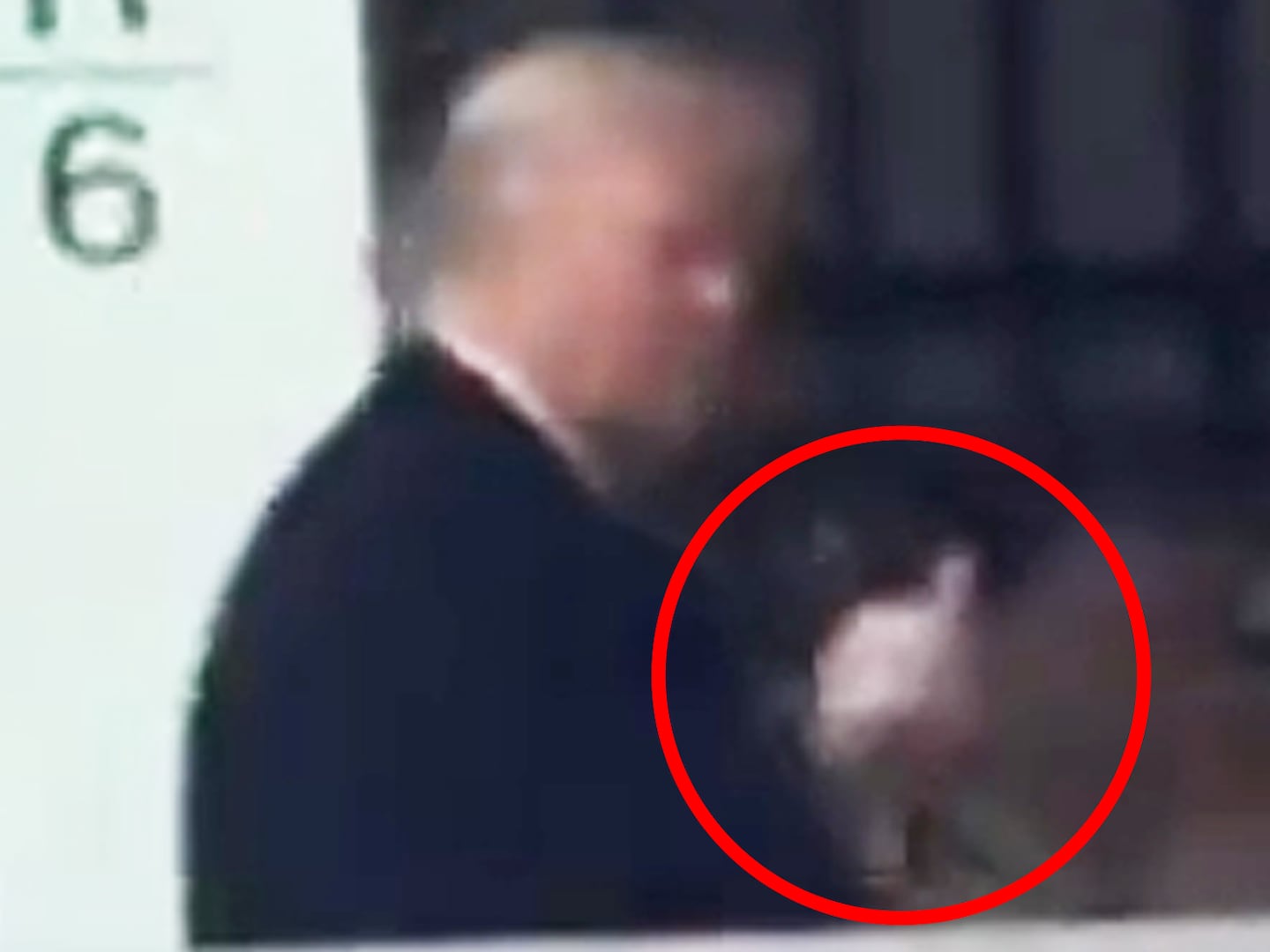My twin daughters just finished their second week of kindergarten at the local elementary school, one of 226 learning facilities in the San Diego Unified School District.
They love it so far, and so do my wife and I. Their teacher is fantastic, the principal is energetic and engaged with the students and their families, and most of my kids’ neighborhood friends go there—it’s just this side of idyllic. Okay, so it could use a few amenities. Shade, for instance. I stopped by at recess yesterday and some kids were huddled under one of the three trees on campus, while others leaned against a steel storage unit to make use of its slim shadow. It seems to me like the district could spring for a couple more drought-resistant trees, or some sailcloth to suspend over the playground. That, and we could use another kindergarten teacher.
One thing I didn’t realize we needed is a Mine-Resistant Ambush Protected Vehicle (MRAP). But our school district now has one. Ours is the Caiman model, a 6x6 behemoth that weighs in at over 15 tons and makes Humvees shrivel up with feelings of inadequacy. The Caiman offers a range of option packages, from bristling-with-machine-guns, to monster-truck-field-hospital. But we got ours used, so we have to make some modifications in order for it to serve our purposes, which were not immediately clear when a local news site broke the story before the District was ready for the official rollout.
Not everyone in the district thinks we need a tactical military vehicle, but it’s hard to argue that the price was not right. Blue Book on this rig is about $750,000, and we got it for nothing. Nada. We just had to pay 5k to transport it. My initial reaction? Whoever pulled the trigger (so to speak) on this acquisition may have just been caught up in the moment. I understand the impulse to act on a good deal. Some people just can’t resist. My father-in-law, for instance, has bought at least three cars that he didn’t need just because they were cheap.
The SDUSD Police picked up the MRAP through the Department of Defense’s Excess Property Program, known as “1033,” a hand-me-down scheme that allows the military to offload unneeded equipment onto local law enforcement agencies. The program was developed in 1997 as a way to equip police to fight the so-called War on Drugs; and now, thanks to our country’s new era of constant actual war, we taxpayers own a lot of military equipment. Since it would be unconscionable to let it go to waste when the real military doesn’t need it anymore, everything from printers to grenade launchers are available to police for the asking. Items like tactical vehicles were originally meant to go to High Intensity Drug Trafficking Areas (HIDTAs), but they are so abundant now that practically anyone with a badge can get one by filling out a one-page request form.
This program is not without its critics, to say the least. Scenes of local police forces wearing camouflage, aiming sniper rifles at civilians, and rolling through places like Ferguson, Missouri in MRAPs as its citizens peacefully protest are a bit much for some of us. Even senators from disparate points on the political spectrum are criticizing the militarization of local law enforcement as being “out of control.”
So the optics were not good for SDUSD’s new monster truck upon its unplanned unveiling. “What on earth would the school police need with a tank?” San Diegans have been asking. (It’s not exactly a tank, of course; but it might as well be, based on its visual and emotional impact.)
School police spokesmen have been trying to answer that question all week. And if their explanations keep evolving, by next Friday the MRAP could be reinvented conceptually as after-prom transport, a food-truck, or just a dent-proof vehicle for Driver’s Ed instructors to teach kids how to parallel park their parents’ over-sized SUVs.
In an article that came out on Tuesday, Captain Joe Florentino told Inewsource, “When we have an emergency at a school, we’ve got to get in and save kids. Our idea is, ‘How can we get in and pull out a classroom at a time of kids if there’s an active shooter?’ ‘If there’s a fire [or] if there’s an earthquake, can we rip down a wall?’ Stuff like that.”
As many commenters on the article and elsewhere pointed out, there are logistical problems with this plan. San Diego Unified School District is the second largest in California: in terms of geography, it’s about 22 miles long and 23 miles across. According to the FBI, the average school shooting lasts for 12 minutes, which is probably not enough time to get a crew assembled at the facility where the MRAP is stored, much less drive through miles of SoCal traffic. SDPD and Fire Rescue would probably be on the scene long before anyone remembered where they had left the keys to the MRAP. Even if the shooting were an atypically protracted event, or the MRAP just happened to be in the neighborhood, in the case of many campuses, the vehicle couldn’t get very close to the classrooms. In short, the critics argued, the chances that this machine could ever be useful were minimal.
Along with Captain Florentino’s statement, SDUSD also released a ‘shopped photo of what they hoped the Caiman would look like after its modification and custom paint job: gun-metal gray with black wheels, “POLICE” emblazoned across the side in foot-tall letters, a much smaller “RESCUE” logo above the front fender, and a red cross behind the front door.
The day after the Inewsource article came out, District Police Chief Ruben Littlejohn spoke at a news conference, reassuring San Diegans that the MRAP didn’t represent a militarization of schools. "There will be medical supplies in the vehicle,” Littlejohn said. “There will be teddy bears in the vehicle. There will be trauma kits in the vehicle in the event any student is injured, and our officers are trained to give first aid and CPR." He mentioned that the district is looking for donors to supply the tens of thousands of dollars worth of medicine and supplies they hoped to keep at the ready.
At the time of the news conference, the school district also rolled out a new look for the MRAP. The latest image features an all-white truck with white wheels and red letters that read “SEARCH & RESCUE.” The “POLICE” logo was nowhere to be seen.
I spoke to Ursula Kroemer, SDUSD’s Public Information Officer, and asked her more about some of the criticisms of the newly acquired MRAP. Were there any hidden costs? Do the officers who crew this rig need special training? Was it really, as I suspected, ordered on a whim by some yahoo who was deeply affected by a childhood encounter with Grave Digger?
When I asked Ms. Kroemer about projected costs to modify the vehicle, she explained that “most of the work was done before it even arrived.” The MRAP had been stripped of any weaponry, and all that remained was to add seating and storage on the interior. As for the paint job, that would be handled by teenagers in the auto shop class at one of the high schools. “They think it’s cool,” Ms. Kromer said.
Was there any expensive training the officers would have to undergo? According to Ms. Kroemer, they were in the process of obtaining Class B drivers’ licenses for four of the officers (two officers already have them), and that would be the extent of the extra training.
As to whether the MRAP was an impulse buy, Ms. Kroemer assured me it was not. “Our school police had actually been looking for grant opportunities to acquire an armored vehicle for this exactly this purpose,” she said. “There has been a lot of research within law enforcement that shows it is very difficult to be defensible against assault weaponry in the case of an active shooter.”
She explained that the MRAP was not their first choice, but when it became available, they applied for it. She also reiterated that it could be useful not only in the event of a school shooting, but for earthquakes and floods as well, something the district took into consideration while shopping. “It was conceived,” she said, “as kind of a safe sanctuary on wheels.”
Then Ms. Kreomer turned the tables on me and asked how I felt, as a parent, about whether it was a good idea to have a resource like the MRAP available, should the unthinkable happen.
After our conversation, and my own mulling, I was convinced me that SDUSD Police had anything but sinister intentions when they filled out the application to win a free truck. It was just so big, and so awesome, and so…free! And there is a miniscule chance that it could save the lives of children in a few very specific disaster scenarios. (And it was free!)
It’s difficult for me to argue against keeping the MRAP around just in case, as long as it’s not siphoning funds that could go toward teachers’ salaries or classroom improvements. I’m all for swords-to-ploughshares, and if we can find civilian uses for military equipment that don’t involve terrorizing our citizenry, we should do so. Maybe the SDUSD Teddy Bear Truck will be a shining example of how we can avoid wasting countless millions of taxpayer dollars by destroying or mothballing perfectly good equipment. I still don’t think we need an MRAP per se, but I would rather this declawed version collect dust in a school district garage than have some gung-ho sheriff order one with a .50-cal mounted on top, keeping his fingers crossed that he’ll have the opportunity to use it.
Despite the very long odds that this acquisition will ever be used, and the sometimes-clumsy way the surprise rollout has been handled, I appreciate the district trying to take advantage of programs that will bring assets to our schools on the cheap. I’m sure there are even more surplus military items available that might be useful. Maybe a bunch of that camouflage netting that they hide tanks under—we could tie-die it in school colors and drape it over the sports field so our kids can get out of the blazing sun at recess.






